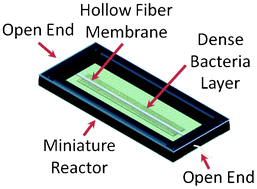In situ hollow fiber membrane facilitated CO2 delivery to a cyanobacterium for enhanced productivity
Abstract
Recently, cyanobacteria have been metabolically engineered to secrete valuable biofuel precursors eliminating the requirement to harvest and post-process algal biomass. However, development of new photobioreactors (PBRs) that can efficiently deliver light and address the mass transport challenges associated with maintaining high cyanobacteria productivity has been lagging. Hollow fiber membranes (HFMs) are a method for bubble-less gas exchange which has been shown to be effective at enhancing mass transfer. Previous applications of HFM technology to PBRs have been limited to exploring its ability to enhance CO2 delivery to the bulk liquid volume. To investigate potential strategies for novel PBR design configurations, we examined the growth pattern of Synechococcus elongatus around individual HFMs to determine the optimal spacing and conditions for maximizing photosynthetic activity. We have shown that a single fiber enabling passive transport from/to the atmosphere can provide enough gas exchange to increase biomass accumulation by >2.5 times with respect to a non-fiber control. This increased growth was found to decay in the radial direction with the enhanced growth area spanning between 1.2 mm and 1.7 mm depending on the initial inoculation concentration.


 Please wait while we load your content...
Please wait while we load your content...